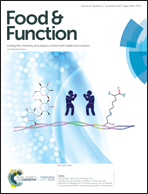A new dual-peptide strategy for enhancing antioxidant activity and exploring the enhancement mechanism
Abstract
The development of a new generation antioxidant peptides with high free radical scavenging rates is highly desirable, but remains a great challenge. Herein, a new dual-peptide development strategy based on plant and animal proteins has been proposed to enhance the antioxidant activity of peptides. Sea cucumber peptide and pine nut peptide were selected to assemble the dual-peptides, namely, VTPYKDHCH and VTPYQDHCH. The in vitro antioxidant activity of the dual-peptides was confirmed to be much higher than that of the individual peptides VTPY, KDHCH, and QDHCH according to the DPPH and ABTS radical scavenging and EPR experiments. The antioxidant activity of the dual-peptides was also further confirmed via cell experiments. Moreover, circular dichroism (CD), Raman spectrum and 1H NMR spectrum were recorded to determine the enhancement mechanism, which showed that the enhancement activity was derived from the increase in the random crimp degree of the secondary structure after the two different proteins were bound together. Our findings are expected to establish a new dual-peptide strategy for the enhancement of antioxidant activity based on plant and animal sources and encourage the further exploration of dual-peptides for functional applications.



 Please wait while we load your content...
Please wait while we load your content...